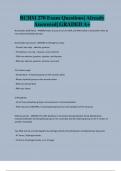BCHM 270 Exam Questions| Already
Answered| GRADED A+
Nucleotides (definition) - ANSWER-basic structural unit for DNA and RNA (called a nucleoside if they do
not contain phosphate groups)
Nucleotides (structure) - ANSWER-1) Nitrogenous base
- Purines: two rings - adenine, guanine
- Pyrimidines: one ring - cytosine, uracil, thymine
- DNA uses adenine, guanine, cytosine, and thymine
- RNA uses adenine, guanine, cytosine, and uracil
2) 5-carbon sugar
- Deoxyribose: no hydroxyl group on the second carbon
- Ribose: hydroxyl group on the second carbon
- DNA uses deoxyribose
- RNA uses ribose
3) Phosphate
- Up to three phosphate groups can be present in mononucleotides
- When bound in DNA/RNA, one phosphate group forms the backbone of the structure
DNA (structure) - ANSWER-The DNA backbone is formed by phosphodiester bonds (dehydration
reactions) between the phosphate group of one nucleotide and the hydroxyl group on the 3' carbon of
another nucleotide
Two DNA strands are held together by hydrogen bonds formed between complementary base pairs
- AT forms 2 hydrogen bonds
- CG forms 3 hydrogen bonds, so is stronger
,DNA mutations - ANSWER-Polymorphisms: variations in characteristics (eg. eye colour, hair colour) due
to alleles (variant genes)
Point mutations: single nucleotide changes
- Silent mutation: amino acid is not changed
- Missense mutation: amino acid is changed
- Nonsense mutation: premature stop codon results in a smaller protein
- Frameshift mutation: an insertion or deletion shifts the enter amino acid sequence
Functional mutations: mutations are classified based on how they affect the function of the protein
- Gain of function mutation
- Loss of function mutation
- Dominant negative function mutation: dysfunctional proteins also reduce the function of the nun-
mutated allele's protein
RNA (structure) - ANSWER-- Single stranded
- Ribose is more polar than deoxyribose, which prevents a double helix from forming
Amino acids (structure) - ANSWER-- building blocks of proteins (chiral except for glycine, so have D and L
forms)
Consist of 4 groups bound to an alpha carbon:
- Alpha amino group (can have 1-3 hydrogens)
- Alpha carboxyl group (can lose the hydroxyl hydrogen to become negative)
- R group (identifying factor)
Joined by peptide bonds between the carboxyl group of one amino acid and the amino group of the
other - condensation reaction; very stable bonds requiring enzymes to catalyze hydrolysis
Amino acids (types) - ANSWER-Nonpolar side chains: cannot form hydrogen or ionic bonds, hydrophobic
,- Glycine, alanine, valine, phenylalanine, leucine, isoleucine, tryptophan, methionine, proline
Uncharged polar side chains: R-groups do not form ionic bonds, but can still participate in hydrogen
bonds
- Serine, threonine, tyrosine, asparagine, glutamine, cysteine
Acidic side chains: negatively charged, allowing salt bridges to form
- Aspartic acid, glutamic acid
Basic side chains: positively charged, allowing salt bridges to form
- Histidine, lysine, arginine
Glycine - ANSWER-Gly, G
smallest side chain (hydrogen), which adds flexibility to the peptide chain
Alanine - ANSWER-Ala, A
side chain contains C and H
Valine - ANSWER-Val, V
side chain contains C and H
Phenylalanine - ANSWER-Phe, F
contain a benzene ring (aromatic)
Leucine - ANSWER-Leu, L
, side chain contains C and H
Isoleucine - ANSWER-Ile, I
side chain contains C and H
Tryptophan - ANSWER-Trp, W
contain a benzene ring (aromatic)
Methionine - ANSWER-Met, M
contains a sulfur along with carbon and hydrogen on its side chain
Proline - ANSWER-Pro, P
R group is bound to amino group, creating a rigid kink in amino acid chain
Serine - ANSWER-Ser, S
have a hydroxyl group capable of forming hydrogen bonds
Threonine - ANSWER-Thr, T
have a hydroxyl group capable of forming hydrogen bonds
Tyrosine - ANSWER-Tyr, Y




